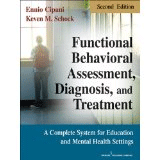Functional Behavioral Assessment, Diagnosis, and Treatment

By Ennio Cipani and Kevin M. Schock
Springer Publishing Company, LLC
New York, NY, 2011
Resource ideal for university coursework
Reviewed by James K. Luiselli, Ed.D., ABPP, BCBA-D
As the title suggests, this book has applied behavior analysis (ABA) as its central philosophy and orientation. Specifically, the content focuses on functional assessment and assessment-derived treatment procedures that have evidence-based research support. Cipani and Schock wrote the book to provide “a comprehensive approach to designing behavioral treatments for children in homes and residential facilities, students in special and general education settings and adults residing in inpatient units and facilities.”
The authors specify that the primary audience for the book is graduate students in ABA but also professionals with different levels of behavioral expertise. Be advised that the material is geared toward readers who have basic knowledge of ABA principles and experience implementing them. More novice students and practitioners will require supervision and mentoring as they progress through each chapter. On a related note, the book is structured as a “how to” instructional guide and not an edited volume of mixed topics.
Cipani and Schock succeed in presenting a contemporary and comprehensive overview of behavioral measurement, intervention and single-case evaluation methodologies. Functional behavioral assessment and functional analysis, the hallmarks of ABA practice, are discussed with precision and a keen eye toward hypothesis-driven treatment formulation. So, too, is the presentation of key concepts and applications such as motivating operations, teaching people replacement skills and adhering to a function-based diagnostic classification system. The teaching tools in the book are many, including case illustrations, summary tables, discussion questions, graphs and numerous recording forms. There is another nice feature in certain sections of the book: a Web site that links to brief videos and Powerpoint presentations narrated by Cipani. I sampled a few of them and found that they very positively augment the written text!
In a large section of the book, Cipani and Schock take on the difficult task of presenting standardized templates for writing treatment plans. They designed protocols, each one in a similar format, in total covering 11 separate treatment options. These protocols are narrative-dense with extensive supplementary material so they demand careful reading. They do, however, bring home the point that ABA intervention for skill building and behavior support must be informed by assessment and analysis of the conditions that promote and maintain a person’s learning history.
This book, it seems to me, is ideal for university coursework in ABA or a seminar devoted to functional assessment and analysis. In fact, as another bonus feature, the publisher allows qualified faculty who adopt the book access to an online instructor’s manual. You could also use the book profitably in a behaviorally oriented training program with human services practitioners. As a teaching and instructional guide, “Functional Behavioral Assessment, Diagnosis, and Treatment” is a first-rate resource for students and young professionals new to the field of ABA or looking to expand their knowledge and practice competencies.
James K. Luiselli, Ed.D., ABPP, BCBA, is senior vice president, applied research, clinical training and peer review at the May Institute in Norwood, Mass.
Learn more about the book: Functional Behavioral Assessment, Diagnosis, and Treatment, Second Edition: A Complete System for Education and Mental Health Settings

November 25th, 2018 at 9:23 pm Micheline posted:
Micheline posted:
It is also a major reason for disability.
April 28th, 2020 at 1:38 am a free robux app posted:
a free robux app posted:
Do you have any video of that? I’d like to find out some additional information.